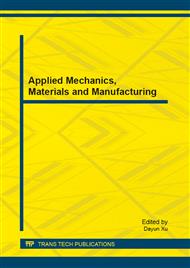[1]
J. Yoon, D. An, W. Yoo, Y. Kwon, Differences in activities of the lower extremity without heel contact during stair ascent by young women wearing high heeled shoes, J Orthop Sci, vol. 14, pp.418-422, (2009).
DOI: 10.1007/s00776-009-1351-x
Google Scholar
[2]
M. Mandato, E. Nester, The effects of increasing heel height on forefoot peak pressure, Am. Podiatr. Med. Assoc, vol. 2, pp.75-80, (1999).
DOI: 10.7547/87507315-89-2-75
Google Scholar
[3]
A. Voloshin, D. Loy, Biomechanical evaluation and management of the shock waves resulting from high-heel gait, Gait Posture, vol. 2, no. 2, p.117–122, (1994).
DOI: 10.1016/0966-6362(94)90101-5
Google Scholar
[4]
M. Esenyel, K. Walsh, J. Walden, Kinetics of high-heeled gait, J. Am. Podiatr. Med. Assoc, vol. 93, no. 1, pp.27-32, (2003).
DOI: 10.7547/87507315-93-1-27
Google Scholar
[5]
R. Gu, J. Li, Y. Li, B. Zhang. Lifting heel full longitudinal arch stress distribution under the finite element analysis, Sports Science, vol. 25. no. 11, pp.85-86, (2005).
Google Scholar
[6]
D. Murphy, D. Connolly, B. Beynnon, Risk factors for lower extremity injury, British Journal of Sports Medicine, vol. 37, no. 1, pp.13-29. (2003).
Google Scholar
[7]
R. Snow, K. Williams, High heeled shoes: their effect on center of mass position, posture, three-dimensional kinemics, rearfoot motion, and ground reaction forces, Arch. Phys. Med. Rehabil, vol. 75, no. 5, pp.568-576, (1994).
DOI: 10.1016/s0003-9993(21)01622-1
Google Scholar
[8]
R. Hao, J. Zhou, D. Jin, The influence of different foot landmark on the human gait, Journal of tsinghua university, vol. 46, no. 8, pp.321-325. (2000).
Google Scholar
[9]
S. Yan, Z. Liu, Research on young women who wear different high heels during natural walking gait, Medical biomechanics, vo. 23. no. 5, pp.394-399, (2008).
Google Scholar
[10]
J. Wu, J. Li, Biomechanics research on women wearing different shoes, Shanghai sports research, vol. 24. no. 3, pp.9-11, (2003).
Google Scholar
[11]
C. Frey, F. Thompson, J. Smith, American Orthopaedic Foot and Ankle Society women's shoe survey, Foot Ankle, vol. 14, no. 2, pp.78-81, (1993).
DOI: 10.1177/107110079301400204
Google Scholar
[12]
A. Voloshin, D. Loy, Biomechanical evaluation and management of the shock waves resulting from high-heel gait, Gait Posture, vol. 2, no. 2. pp.117-122, (1994).
DOI: 10.1016/0966-6362(94)90101-5
Google Scholar


